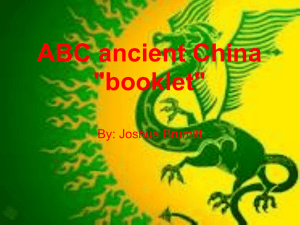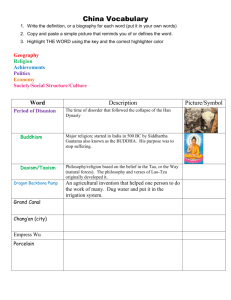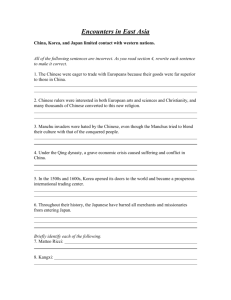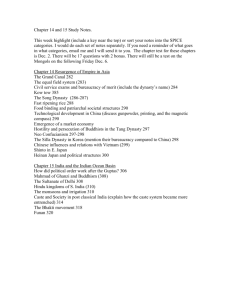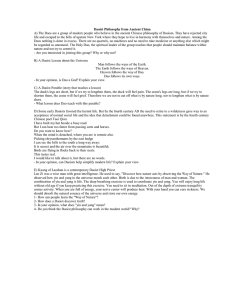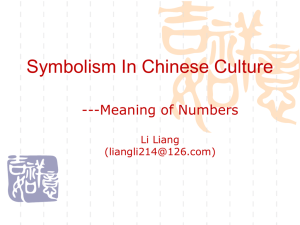chinese art - Mayfield City School District
advertisement
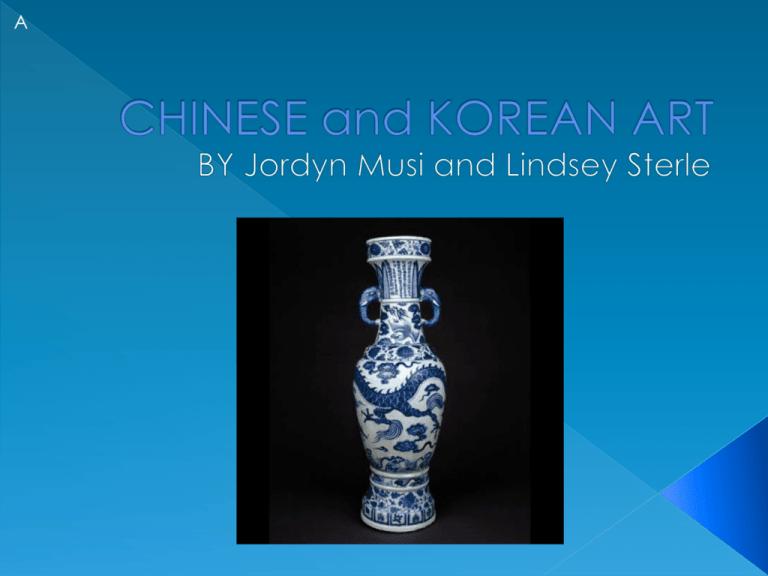
A P A o “Khan Academy." Khan Academy. N.p., n.d. Web. 02 Dec. 2015. o Nici, John B. Barron's AP Art History. Hauppauge, NY: Barron's Educational Series, 2008. Print. R o Great religions were established in and spread throughout Asia o Buddhism, Hinduism, Daoism, Islam, Christianity o o o o The intertwining of crowded and empty spaces is a reflection of the Daoist theory of Ying and Yang, in which opposites flow into each other. The first ruler to unite China was emperor Shi Huangdi A particularly long lasting period in Korea was formed during the Silla dynasty, which united with the Tang Dynasty https://www.youtube.com/watch?v=NIC4zom3w0 g T 15th century C.E. ~ Ming Dynasty ~ Beijing, China o Stone masonry, marble, brick, wood, and ceramic tile o Largest and most complete Chinese architecture in existence o 9,000 rooms o Walls 30 feet tall to keep people out and those inside in o Only the royal court could ender (Hence name ‘Forbidden’ city) H o Each corner of the rectangular plan has a tower representing the four corners of the world o Focus is on Hall of Supreme Harmony o Throne room and seat of power o Wood structure made with elaborately painted beams o Meant for grand ceremonies: new years, emperor’s birthday, the minter solstice o Surrounding walls are characteristic of a Chinese city: privacy within provides protection; containment part of Chinese culture I Western Han Dynasty ~ 168 B.C.E. ~ Hunan Provincial Museum, Changsha o Lady Dai died in 168 B.C.E. in the Hunan province (Han Dynasty) o Her tomb was found with over 100 objects inside T-shaped silk banner covered the inner coffin o Most likely carried in a procession to the tomb, then placed over the body– thought to speed the journey to the afterlife o o Yin symbols on the left, Yang on the right S o Painted in three distinct sections o Top: o left – heaven with crescent moon o center – two seated officers guard the entrance to heaven o right – legend of ten suns o Middle: earth with Lady Dai in center making journey to heaven with walking stick; mourners and assistants on her side; dragons’ circle in a yin and yang exchange o Bottom: the underworld, framed by fish, turtles, and dragon tails; a tomb guardians protects body Vocabulary Yin and yang: complementary polarities. The yin is a feminine symbol with dark, soft, moist, and weak characteristics. The yang is the male symbol that has bright, hard, dry, and strong characteristics. T Paints by Fan Kuan ~ 1000 C.E. ~ National Palace Museum, Taipei, Taiwan o Ink on silk o Hanging scroll o Artist isolated himself so he could be with nature and study it; Daoist philosophy o He produced very complex landscapes o May be Fan Kuan only surviving work; signature hidden in bushes on the lower right O o Different brush strokes represented different kinds of trees: coniferous, deciduous, etc. o Long waterfall on right balanced by mountain of left; waterfall accents height of the mountain o Not a pure landscape: donkeys laden with firewood are driven by two men; a small temple appears in the forest; man seen as small and insignificant o Mist created by ink washes; silhouette the roofs of the temple Vocabulary Daoism: a philosophical belief begun by Laozi that stresses individual expression and a striving to find balance in one’s life R 1417-1475 C.E., Korea o Hanging scroll o Ink and color on silk o Sin Sukju was the Korean Prime Minister (1461-1464 and 1471-1475) and a soldier o Repainted over the years, especially in 1475 when he died Y o Korean portraits emphasize how the subjects made a great contribution to the country and how the spirit of loyalty to king and country was valued by Confucian philosophy o Portrait was made when he was a second grade civil officer: insignia designed with clouds and a wild goose Vocabulary Confucianism: a philosophical belief begun by Confucius that stressed education, devotion to family, mutual respect, and traditional culture. I Portrait of Sin Sukju Lindisfarne Gospels, Saint Luke o Frontal view of stool o Ink and color on silk o Feet on stool represents figure of power/authority o Sin Sukju made great contributions to the country o Frontal view of stool o Vellum o Halo represents figure of divine power S 1969 C.E. ~ Private Collection o Color lithograph o Based on an oil painting by Liu Chunhua o Iconic representation of the Great Leader’s career o Painted during the Cultural Revolution of 1966-1976; high art was dismissed as feudal or bourgeois o Poster-like; vivid colors, dramatic and obvious political message T o Art was done anonymously; individual artistic fame seen as counter cultural in a collectivist society o The image is a moment in the 1920’s; Mao on his way to Anyuan to lead a miner’s strike o Mao worked for reforms for miners; supported a local strike for better wages, working condition, and education o For many people, this action formed a permanent bond with the communist party o May be most reproduced image ever: 900,000,000 copies H 221-209 B.C.E. ~ Qin Dynasty ~ Lingtong, China o Discovered in 1974 o Made of terra-cotta o Originally colorfully painted o Daoism seen in the individualization of each soldier despite how many there were E o About 8,000 terra-cotta warriors o 100 wooden chariots o 2 bronze chariots o 30,000 weapons o Soldiers are six feet tall with differing expressions; some fierce, some proud, some confident o Representation of a Chinese army marching into the next world B Army of Emperor Shi Huangdi Army of Emperor Shi Huangdi o Terra-cotta o used in burial o All males, with differing appearances o China, Qin Dynasty o Ceramic o Used in burial o Females and males; differing appearances o Near East, Sumerian E 493-1127 B.C.E. ~ Tang Dynasty ~ Luoyang, China o limestone o Caves along the banks of the Yi River o Carves from existing rock; some large, some small o 800,000 people worked on the site o 110,000 Buddhist stone statues o 60+ stupas o 2,800 inscriptions on steles S o Buddha arranged as if on an altar of a temple, deeply set into the rock face o Inscription states that the Empress Wu Zetian was the principal patroness of the site, and she used her private funds to finance the project o Vairocana Buddha having monk attendants, bodhisattvas, and guardians flanking him o Elongated lags and exaggerated poses Vocabulary Bodhisattva: a deity who refrains from entering nirvana to help others T 5th-6th century C.E. ~ Seoul, South Korea o Uncovered in a royal tomb in Gyeongju, Korea o Symbolizes geometric trees o Antler forms influenced by Shamanistic practices in Siberia o Very light weight; had limited use o Possibly used for ceremonial occasions, but perhaps only for burial C 1351 ~ British Museum, London o White porcelain with cobalt blue underglaze o One of the most important examples on blue and white porcelain o Made for the alter of a Daoist temple, along with an incense burner o Dedication of the side of the neck on the vase (earliest dedication on a blue and white porcelain vase) o Blue color imported from Iran L o Handles shaped like elephant heads o The neck and foot of vase are decorated as flowers and leaves o The central section is a Chinese dragon with traditional long bodies, beards, scales, and claws o Names after Sir Percival David, a collector of Chinese art Vocabulary Porcelain: a ceramic made out of clay that when fired in a kiln produces a product that is hard, white, brittle, and shiny A https://www.khanacademy.org/ humanities/art-asia/imperialchina/yuan-dynasty/v/davidvases S Thanks for watching! S Pop Quiz to see if you were paying close attention to our power point: Each slide had a letter in the upper left hand corner. If put together, they spell out a sentence. What is that sentence (First correct answer gets a prize)




